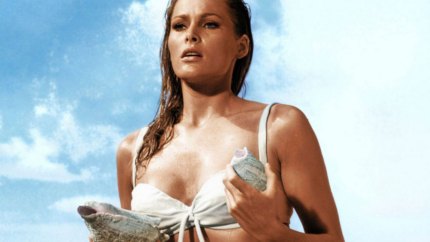
Tim Gray, Variety про бікіні в голлівудському кіно.
It’s National Bikini Day on July 5, celebrating Louis Reard’s 1946 invention of the swimwear (of course it would be in France!). The swimsuit wasn’t an immediate hit, though, due to 1940s standards of modesty. But pop culture helped bring it to the masses, thanks to such early-1960s icons as Brigitte Bardot, Ursula Andress, and Raquel Welch.
In 1960, the novelty song “Itsy Bitsy Teenie Weenie Yellow Polkadot Bikini,” sung by Brian Hyland, became a No. 1 hit in the U.S. and the record company said bikini sales boomed as a result. And in 1962, Andress emerged from the water in the James Bond “Dr. No,” while Bardot appeared in “A Very Private Affair,” both in small white two-piece suits. And nothing was the same after that.
In 1964, American International Pictures released “Bikini Beach,” the third of its “Beach Party” movies starring Frankie Avalon and Annette Funicello. “Bikini Beach” featured surfers, bikers, a chimpanzee, Beatlemania, Boris Karloff, and a musical performance by Little Stevie Wonder. In the July 1964 review, Variety said that the screenplay, attributed to three writers (William Asher, Leo Townsend, Robert Dillon), “is mostly a series of gags tied together with a frayed string of logic.”
That movie helped establish the fact that a snappy title was more important than a tight script, and in the next two years, AIP released “How to Stuff a Wild Bikini,” “Dr. Goldfoot and the Bikini Machine” (which against all logic, even had a title song), and “The Ghost in the Invisible Bikini.” The word became an important marketing tool. A very early Bardot film, “La fille sans voile,” had been titled in English as “The Lighthouse Keeper’s Daughter.” But after she and the bathing suit became famous, the film got a U.S. release under the new title “The Girl in the Bikini.” Mon dieu.
Welch wore a bikini in many of her early films, most famously her fur suit in “One Million Years B.C.” but also including “Fathom,” “Lady in Cement,” and “Biggest Bundle of Them All.” It became a rite of passage for every pretty young actress to pose in a bikini. That long list includes such eventual Oscar winners as Jane Fonda, Shirley MacLaine, Rita Moreno, Faye Dunaway, Jodie Foster, Halle Berry, and, yes it’s true, Helen Mirren and Judi Dench.
But they were in the film world; TV was more prim.
NBC wouldn’t let Barbara Eden show her navel in her harem outfit on “I Dream of Jeannie” (1965-1970); in those days, tight bathing suits for women were okay on TV, as long as they were one-piece. But among the fast changes in the 1960s: NBC’s “Laugh-In” debuted in 1968, and Goldie Hawn, Chelsea Brown, and Judy Carne could do their go-go dancing in bikinis (though often body paint distracted from their navels).
Carrying on the AIP bigscreen tradition, there have been decades of films like “Bikini Car Wash Company” (1992), “Bikini Drive-In” (1995), and “Bikini Car Wash Massacre” (2017), titles so vivid that plot goes out the window.
Amid all this, there was only one actor bold enough to remind people that a man could be memorable in a two-piece bikini: Jim Carrey, in Fox’s sketch comedy “In Living Color,” which began in 1990.
Tim Gray, Variety, 5 липня 2017 року
